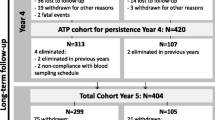Abstract
With the emergence of multiple meningococcal serogroups in different geographic areas, broad vaccine protection from infancy is desirable. One hundred and seventy-five infants received either two doses of a meningococcal quadrivalent (A, C, W-135, Y) conjugate vaccine (MenACWY-CRM) at 6 and 12 months, one dose of MenACWY-CRM at 12 months, or MenC at 12 months and MenACWY-CRM at 18 months. Bactericidal antibody titers using human complement were measured before and 1 month after each dose. Injection-site reactions were reported by 22–45% of participants following MenACWY-CRM given at 6 or 12 months. Similar proportions of subjects had injection-site reactions following two doses of MenACWY-CRM (32–41%) or one dose of MenC (26–44%). The incidence of systemic adverse events was comparable between groups. After two doses of MenACWY-CRM, the percentages of participants reporting hSBA titers ≥8 were 100% for C, W-135, and Y, and 84% for A. Serogroup C titers were more than 10-fold higher after two doses of MenACWY-CRM than after one dose of MenC or MenACWY-CRM at 12 months. Serogroup C titers were comparable following a single dose of MenACWY-CRM or MenC at 12 months. MenACWY-CRM is well tolerated and immunogenic given at 12 months, or two doses at 6 and 12 months of age.


Similar content being viewed by others
References
Erickson L, De Wals P (1998) Complications and sequelae of meningococcal disease in Quebec, Canada, 1990–1994. Clin Infect Dis 26:1159–1164
Bilukha O, Messonnier N, Fischer M (2007) Use of meningococcal vaccines in the United States. Pediatr Infect Dis J 26(5):371–376
Pollard AJ (2004) Global epidemiology of meningococcal disease and vaccine efficacy. Pediatr Infect Dis J 23(12 Suppl):S274–S279
Centers for Disease Control and Prevention (CDC), Active Bacterial Core Surveillence Reports, Emerging Infectious Program Network, Neisseria Meningitidis. 2005
World Health Organization (WHO) (1998) Control of epidemic meningococcal disease: WHO practical guidelines, 2nd edn. WHO, Geneva
MacDonald NE, Halperin SA, Law BJ, Forrest B, Danzig LE, Granoff DM (1998) Induction of immunologic memory by conjugated vs. plain meningococcal C polysaccharide vaccine in toddlers: a randomized controlled trial. JAMA 280:1685–1689
Gold R, Lepow ML, Goldschneider I, Draper TL, Gotschlich EC (1975) Clinical evaluation of group A and group C meningococcal polysaccharide vaccines in infants. J Clin Invest 56:1536–1547
Snape MD, MacLennan JM, Lockhart S, English M, Yu L-M, Moxon RE, Pollard AJ (2009) Demonstration of immunologic memory using serogroup C meningococcal glycoconjugate vaccine. Pediatr Infect Dis J 28:92–97
Heath PT (1998) Haemophilus influenzae type b conjugate vaccines: a review of efficacy data. Pediatr Infect Dis J 17:S117–S122
Snape MD, Pollard AJ (2005) Meningococcal polysaccharide-protein conjugate vaccines. Lancet Infect Dis 5(1):21–30
Booy R, Jelfs J, El Bashir H, Nissen MD (2007) Impact of meningococcal C conjugate vaccine use in Australia. Med J Aust 186(3):108–109
Larrauri A, Cano R, García M, de Mateo S (2005) Impact and effectiveness of meningococcal C conjugate vaccine following its introduction in Spain. Vaccine 23:4097–4100
Centers for Disease Control and Prevention (CDC) (2007) Revised recommendations of the Advisory Committee on Immunization Practices to vaccinate all persons aged 11–18 years with meningococcal conjugate vaccine. MMWR Morb Mortal Wkly Rep 56:794–795
Rennels M, King J Jr, Ryall R, Papa T, Froeschle J (2004) Dosage escalation, safety and immunogenicity study of four dosages of a tetravalent meninogococcal polysaccharide diphtheria toxoid conjugate vaccine in infants. Pediatr Infect Dis J 23:429–435
Vu DM, Welsch JA, Zuno-Mitchell P, Dela Cruz JV, Granoff DM (2006) Antibody persistence 3 years after immunization of adolescents with quadrivalent meningococcal conjugate vaccine. J Infect Dis 193:821–828
Goldschneider I, Gotschlich EC, Artenstein MS (1969) Human immunity to the meningococcus. I. The role of humoral antibodies. J Exp Med 129:1307–1326
Snape M, Perrett K, Ford KJ, John TM, Pace D, Yu LM, Langley JM, McNeil S, Dull PM, Ceddia F, Anemona A, Halperin SA, Dobson S, Pollard AJ (2008) Immunogenicity of a tetravalent meningococcal glycoconjugate vaccine in infants: a randomized controlled trial. JAMA 299:173–184
Perrett KP, Snape MD, Ford KJ, John TM, Yu LM, Langley JM, McNeil S, Dull PM, Ceddia F, Anemona A, Halperin SA, Dobson S, Pollard AJ (2009) Immunogenicity and immune memory of a nonadjuvanted quadrivalent meningococcal glycoconjugate vaccine in infants. Pediatr Infect Dis J 28:186–193
Centers for Disease Control and Prevention (CDC) (2007) Notice to Readers: Recommendation from the Advisory Committee on Immunization Practices (ACIP) for use of quadrivalent meningococcal conjugate vaccine (MCV4) in children aged 2–10 years at increased risk for invasive meningococcal disease. MMWR Morb Mortal Wkly Rep 56:1265–1266
Public Health Agency of Canada. Publicly funded immunization programs in Canada—routine schedule for infants and children (including special programs and catch-up programs). Available online at: http://www.phac-aspc.gc.ca/im/ptimprog-progimpt/table-1-eng.php. Accessed 17 February 2009
Trotter CL, Edmunds WJ, Ramsay ME, Miller E (2006) Modeling future changes to the meningococcal serogroup C conjugate (MCC) vaccine program in England and Wales. Hum Vaccin 2:68–73
Acknowledgments
We thank the nurses and staff for their careful attention to detail and to the children and their families for participating in the study. We also thank Dr. Bruce Smith at the Canadian Center for Vaccinology for his independent evaluation of the statistical analysis plan and report and statistical analysis.
Financial interest
A. Anemona and P. Dull are employees of Novartis Vaccines. F. Ceddia was an employee of Novartis Vaccines; current address GlaxoSmithKline Biologicals, Rixensart, Belgium. S. Halperin and F. Diaz-Mitoma had no financial interest in the vaccine or its manufacturer, but received research funding to undertake the study.
The study was funded by Novartis Vaccines.
Author information
Authors and Affiliations
Corresponding author
Additional information
Presented at the 5th World Congress of the World Society of Pediatric Infectious Diseases, 15–18 November 2007, Bangkok, Thailand.
Rights and permissions
About this article
Cite this article
Halperin, S.A., Diaz-Mitoma, F., Dull, P. et al. Safety and immunogenicity of an investigational quadrivalent meningococcal conjugate vaccine after one or two doses given to infants and toddlers. Eur J Clin Microbiol Infect Dis 29, 259–267 (2010). https://doi.org/10.1007/s10096-009-0848-8
Received:
Accepted:
Published:
Issue Date:
DOI: https://doi.org/10.1007/s10096-009-0848-8



